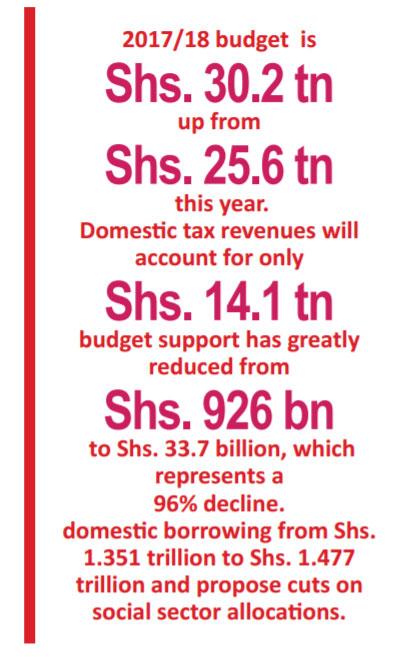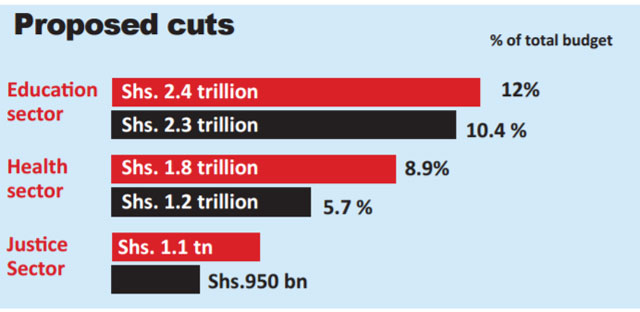
Civil society reacts
But budget cuts have already angered activists led by the Civil Society Budget Advocacy Group (CSBAG) who are now lobbying parliament to stop the Finance Ministry from following through its proposals, currently still contained in the NBFP, which details government plans ahead of the budget.
As things stand, Kasaija’s team led by Muhakanizi, the secretary to the treasury and Kenneth Mugambe, the director budget, appear pushed into a tight corner and with very little room for flexibility.
Mid-last year, it dawned upon them that they had find money to fund oil infrastructure after government set 2020 as the year oil must be pumped out of the ground.
But as the team at Finance moved to plan for funding, their first smack in the face was handed down by donors who cut about Shs.900 billion in budget support and moved their money into project support.
According to Lugoloobi, the donors are not happy because the government has failed to use money it has already acquired either as budget support or debt.
For his part, Muhakanizi appears determined to sugarcoat a bitter reality. Instead of admiting donors have slashed budget support, he prefers to say they have shifted the support to project funding.
Insider sources confirmed that failure to use up budgeted money or what the technocrats call “poor absorption of loans” is behind the cut. The Auditor General this January revealed that loans of up to Shs. 18 trillion -which is as high as the resources available for government to spend this FY – remain unused because of constraints in government department. Top on the list is corruption and incompetence.
This situation, critics say, explains why the government cannot borrow more externally thus resorting to domestic borrowing, which has negative consequences on the economy.
Muhakanizi also insists government is not diverting from the policy, and is in fact reducing domestic borrowing overtime.
He, however, concedes that the donors’ move is punitive in the sense that it was sparked by the 2012 corruption scandals in the Office of the Prime Minister which sacked in the Central Bank, Ministry, and even the Ministry of Public Service.
Muhakanizi correctly points out that the situation has since improved.
He told The Independent: “We have since worked on those governance issues; the situation is much better -donors agree and we are in talks anyway”.
Clearly, however, nothing will be forthcoming in the new FY. The earliest things could change is FY2018/19. Muhakanizi also does not mention that the talks he mentions are a direct result of recent issues that donors are unhappy about. Just last year, the World Bank suspended trillions of shillings in financing because government had implementation issues.
Julius Mukunda, the coordinator, CSBAG, says that the biggest problem is the accumulating debt and the fact that government has no capacity to utilise it and is instead spending heavily on the interest rate payments.
The government’s allocation to interest payments due, is also proposed to jump upwards from Shs2 trillion or 9.9% of total budget to Shs2.3 trillion or 10.3% of total budget. That is far higher than allocation to most government ministries and departments.
“Government has no capacity to absorb yet we are seeing more borrowing,” he told The Independent, “That is why we are witnessing increasing commitment charges.”
The report on public debt (domestic and external loans), guarantees and other financial liabilities and grants for financial year 2015/16 submitted by Kasaija to parliament in March last year revealed that commitment fees paid on undisbursed funds have grown by 191% from $1.75m in 2007/2008 to $4.6m paid in 2013/2014 due to delayed implementation of projects.
Interest payments are also up. In his budget speech last year, Kasaija noted that Shs. 2,022.9 billion was for interest payments on debt. This year of Shs. 2.7 trillion will be spent on interest payments compared to Shs. 1.6 trillion in 2015/16.

This is an increase of 65.4 % in only two years, amidst stagnation in revenue-to-GDP ratio at 13 % for the past 3 years, arising from limited revenue base and the costly infrastructural development according to the World Bank.
Total debt stock has drastically increased from Shs. 33.1 trillion to Shs. 46.2 trillion between 2014/15 to 2015/16. Of this, the money government cannot pay back to the domestic market has to increase Shs. 7.9 trillion or 26.3 % of the total budget.
There is a risk here.
Out of the total domestic debt, government notes in the NBFP, 44.6 percent will be due for repayment in the next 12 months, which is above the recommended benchmark of 40 percent.
Government adds: “This, coupled with the current practice of rolling over maturing debt, implies that Government faces a heightened risk of being unable to refinance its maturing domestic debt. In order to mitigate this risk, Government is taking steps to lengthen the maturity profile of domestic debt by issuing more longer-dated treasury instruments.”
But critics insist that government must first address the poor loan absorption issue, which Auditor General Muwanga warned undermines the attainment of planned development targets because the country end up paying more to the lenders in terms commitment charges.
President Museveni also talked tough over the matter in a cabinet retreat last year.
“Low absorption capacity?” Museveni asked rhetorically, “This not acceptable.”
These revelations also exposed President Yoweri Museveni’s excuse that lack of funding is the major detriment to service delivery. It showed that the problem is failure to absorb.
****
editor@independent.co.ug
 The Independent Uganda: You get the Truth we Pay the Price
The Independent Uganda: You get the Truth we Pay the Price


